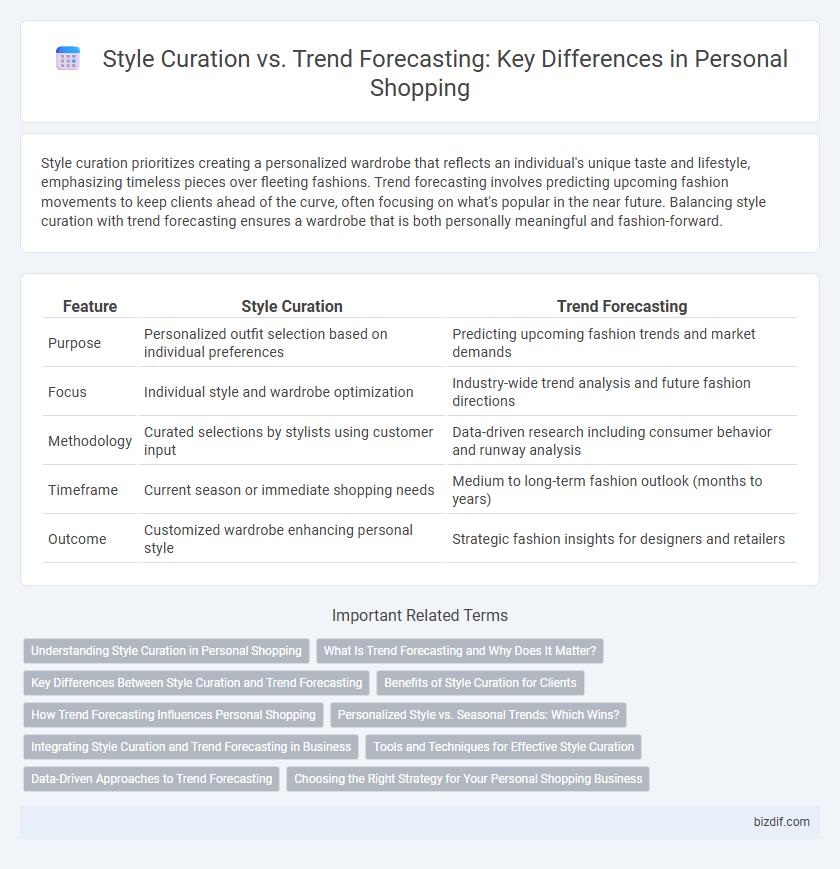Style curation prioritizes creating a personalized wardrobe that reflects an individual's unique taste and lifestyle, emphasizing timeless pieces over fleeting fashions. Trend forecasting involves predicting upcoming fashion movements to keep clients ahead of the curve, often focusing on what's popular in the near future. Balancing style curation with trend forecasting ensures a wardrobe that is both personally meaningful and fashion-forward.
Table of Comparison
| Feature | Style Curation | Trend Forecasting |
|---|---|---|
| Purpose | Personalized outfit selection based on individual preferences | Predicting upcoming fashion trends and market demands |
| Focus | Individual style and wardrobe optimization | Industry-wide trend analysis and future fashion directions |
| Methodology | Curated selections by stylists using customer input | Data-driven research including consumer behavior and runway analysis |
| Timeframe | Current season or immediate shopping needs | Medium to long-term fashion outlook (months to years) |
| Outcome | Customized wardrobe enhancing personal style | Strategic fashion insights for designers and retailers |
Understanding Style Curation in Personal Shopping
Style curation in personal shopping involves a tailored selection of clothing and accessories that align with an individual's unique preferences, body type, and lifestyle, ensuring long-term wardrobe coherence. Unlike trend forecasting, which predicts upcoming fashion movements to influence short-term buying decisions, style curation emphasizes timeless pieces and personal expression over fleeting trends. This approach enhances client satisfaction by creating a personalized, sustainable wardrobe that reflects their identity rather than seasonal fashion demands.
What Is Trend Forecasting and Why Does It Matter?
Trend forecasting involves analyzing consumer behavior, cultural shifts, and market data to predict upcoming fashion movements, ensuring personal shoppers offer clients styles that remain relevant and timely. It matters because anticipating trends helps in building a wardrobe that evolves with the market, balancing uniqueness with broad appeal. Accurate trend forecasting enhances client satisfaction by aligning personal style with future demand, optimizing investment in clothing choices.
Key Differences Between Style Curation and Trend Forecasting
Style curation prioritizes creating a personalized wardrobe that reflects an individual's unique taste, body shape, and lifestyle, focusing on timeless pieces and cohesive outfits. Trend forecasting identifies emerging fashion patterns and predicts market directions, emphasizing short-term popularity and industry-wide shifts. The key difference lies in style curation's emphasis on personal expression versus trend forecasting's focus on collective market trends and future fashion cycles.
Benefits of Style Curation for Clients
Style curation offers personalized wardrobe solutions tailored to individual preferences, body types, and lifestyles, enhancing client confidence and satisfaction. Unlike trend forecasting that emphasizes ephemeral fashion cycles, style curation creates timeless looks that maximize wardrobe versatility and longevity. This approach reduces decision fatigue, allowing clients to invest in pieces that truly reflect their identity and personal brand.
How Trend Forecasting Influences Personal Shopping
Trend forecasting significantly shapes personal shopping by predicting upcoming fashion movements and consumer preferences, enabling shoppers to make informed choices aligned with future styles. This process uses data analytics and market research to identify emerging patterns, ensuring personalized selections that stay ahead of seasonal changes. By anticipating trends, personal shoppers can curate wardrobes that balance innovation with individual style, enhancing both relevance and confidence in fashion decisions.
Personalized Style vs. Seasonal Trends: Which Wins?
Personalized style prioritizes individual preferences and body types, creating a unique wardrobe that reflects long-term identity rather than fleeting trends. Seasonal trends focus on the latest fashion cycles, which may quickly become outdated and lack personal relevance. For lasting satisfaction and confidence, style curation tailored to the individual often outperforms trend forecasting in personal shopping.
Integrating Style Curation and Trend Forecasting in Business
Integrating style curation and trend forecasting in personal shopping enhances client satisfaction by combining timeless aesthetics with emerging market insights. Businesses leveraging data analytics to predict trends while tailoring selections based on individual client style create a competitive edge. This synergy drives higher engagement and optimizes inventory management for personalized shopping services.
Tools and Techniques for Effective Style Curation
Style curation relies on advanced tools like AI-powered wardrobe analysis and personalized style algorithms to create customized looks that align with individual preferences and body types. Techniques such as digital mood boards, fabric texture mapping, and color theory application enhance the precision and creativity of style curation. These tools and methods enable personal shoppers to deliver tailored fashion advice that stands the test of time, unlike trend forecasting which centers on predicting short-term market movements.
Data-Driven Approaches to Trend Forecasting
Data-driven approaches to trend forecasting leverage advanced analytics, consumer behavior metrics, and social media insights to predict emerging styles with accuracy. Style curation focuses on personalized selection based on individual preferences, while data-driven trend forecasting uses algorithms and big data to identify macro and micro trends in real-time. Integrating these methodologies enhances personal shopping experiences by aligning curated styles with the latest market movements and consumer demands.
Choosing the Right Strategy for Your Personal Shopping Business
Style curation emphasizes understanding individual client preferences to create timeless, personalized wardrobes that enhance long-term satisfaction and confidence. Trend forecasting leverages industry insights and market analytics to anticipate fashion movements, helping businesses stay competitive and attract fashion-forward clientele. Selecting the right strategy depends on your target market's needs--prioritizing style curation builds client loyalty, while trend forecasting drives relevance in fast-paced fashion environments.
Style curation vs Trend forecasting Infographic

 bizdif.com
bizdif.com